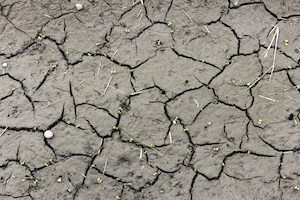Whether you are a lawn care enthusiast or you just want to be able to enjoy your yard, the sudden appearance of cracks in your lawn is most certainly cause for concern. After all, a healthy yard should not have cracks quickly spreading across the lawn. In order to effectively fix the problem, however, you must understand the cause of those pesky cracks.
Why is my lawn cracking? There are two likely explanations for the cracks appearing across your lawn. Cracks in your lawn are actually cracks in the soil underneath. This cracking is most commonly caused by dryness or drought. However, certain soil types are also known to crack over time, affecting your lawn in the process.
So, how do you know which of these culprits is causing the cracks in your lawn? How do you go about fixing lawn cracks? Are there things you can do to prevent cracking in the future? In this post, we will answer these questions and more, providing you with everything you need to know about cracks in your lawn.
Understanding & Fixing a Lawn That is Cracking
Before we start diving into the specifics of what causes cracking in your lawn, you will be relieved to know that this problem often has a simple solution. The most effective and efficient way to fix the cracks in your lawn is to understand what caused the cracks to appear in the first place. Doing so will allow you to take steps towards eliminating the cracks once and for all.
What Causes Your Lawn to Crack
Oftentimes, homeowners fail to recognize cracks in their lawn until they become a significant problem. When they do finally notice the cracks, they become quickly overwhelmed with the scope and size of the lawn issue. Your lawn is likely cracking for one of two reasons. Here are the first two causes to consider as you work towards achieving the yard of your dreams.
Cracking Can Be Caused By Dryness
 More often than not, cracks in your lawn are caused by dryness. Because of this, homeowners who live in hot, arid climates will experience cracking at a greater rate than those living in more temperate climates.
More often than not, cracks in your lawn are caused by dryness. Because of this, homeowners who live in hot, arid climates will experience cracking at a greater rate than those living in more temperate climates.
Regardless of where you live, there are likely seasons throughout the year where your lawn receives less natural precipitation. If you are not watering your grass during these times of drought, your soil begins to dry out. While most types of soil can withstand dry spells to a certain extent, they will all reach a point where there is no more water to absorb.
When this happens, small cracks begin to form. Without water, the cracks will continue to grow and spread throughout your lawn. Cracks in dry soil may be shallow but extend for several feet or they may be shorter in length but have a greater depth.
Cracking Can Be Caused By Soil Type
Most commonly found in the southern portion of the United States, the presence of clay soil can also be the cause of cracks in your lawn. Clay is much more porous than other types of soil. Because of its ability to absorb great amounts of water, it easily expands with rain.
However, clay is also known for its ability to release excess water. While this is incredibly beneficial during seasons of rain, it is also a huge detriment during seasons of drought. When clay soil does not receive adequate water, it begins to shrink. During this shrinking, cracks may begin to form across your lawn.
How to Fix Cracks In Your Lawn
As soon as you notice cracks in your lawn, you are likely ready to find a solution. Fortunately, there are several things you can do to fix the cracks in your lawn and achieve the yard of your dreams. While some of these approaches require a greater time commitment, the reward of a smooth, healthy lawn is hard to beat.
Aerate Your Lawn Before Watering
If your lawn is cracking despite proper watering, it is possible that the water is not able to properly penetrate the soil. This can happen when the soil becomes too compacted over time. The best way to fix this issue is to aerate your lawn to loosen up the soil. There are several approaches to aerating including aerating shoes, aerating tools, or a walk-behind aerator.
Every approach to aerating your lawn achieves the same result, thousands of small holes scattered throughout the yard. The aeration approach you choose will depend largely on the size of your yard.
If you have clay soil, lawn care professionals recommend thorough aeration of your lawn every year. However, if you have sandy soil or do not have problems with drainage, aerating your lawn every 2 to 3 years is sufficient.
Rethink Your Lawn Maintenance Program
 Achieving a soft, lush lawn requires quite a bit of maintenance. Although it may seem overwhelming, it is important to establish a lawn maintenance program that includes aeration, fertilization, mowing, and watering.
Achieving a soft, lush lawn requires quite a bit of maintenance. Although it may seem overwhelming, it is important to establish a lawn maintenance program that includes aeration, fertilization, mowing, and watering.
If you are experiencing cracks in your lawn, it is important to assess your lawn care routine and identify any areas of concern. Pay close attention to your watering routine to make sure your lawn is getting enough water during dry seasons.
Add Other Types of Soil to Clay Soil
Homeowners in southern states understand the many woes of clay soil. While it certainly has its fair share of benefits, it can make lawn maintenance and upkeep difficult. If you experience drought cracks in your lawn year after year, it may be time to consider a more aggressive approach.
Adding 1-2 inches of sandy loam soil to the top of your lawn will help mitigate the possibility of cracking during dry seasons. Sandy loam is tough to work into the clay soil. It is wise to add the sandy loam soil to the top of your lawn before aeration as aerating will help with the incorporation process. You can learn more about types of grass that grow in sandy soil here.
Invest in A Sprinkler System
Rolling out your hose, placing your sprinklers, and remembering to turn them on requires a high level of dedication. If you live in a dry region, you may want to consider investing in an irrigation system. While this is certainly not a small investment, it can go a long way in preventing your lawn from cracking due to dryness.
 Contact a Lawn Care Professional
Contact a Lawn Care Professional
Finally, if you have attempted to fix the crack in your lawn without success or if you believe the problem is too complex, consider contacting a lawn care professional. Lawn care experts will be able to easily identify the cause of the cracks in your lawn and recommend a lawn care maintenance program to alleviate the issue.
Dangers of Cracks In Your Lawn
If you are not concerned about the appearance of your yard, you may be tempted to ignore the cracks in your lawn. However, cracks in your lawn are dangerous for many reasons.
Cracking Can Kill Plants & Grass
Although you may not often consider it, grass and landscaping is a significant expense! Cracks in your lawn shine a light on a much larger grass problem of insufficient water. Additionally, if they are left untreated, cracks in your lawn can continue to extend and kill other plants and areas of your grass.
Cracking Can Cause Widespread Erosion

Especially if you live in an area that receives a significant amount of rain, the grade of your yard is important for protecting the foundation of your home. Cracking in your lawn can cause widespread erosion that may lead to a much larger issue.
Cracks Can Cause Physical Injury to Pets or Humans
Finally, even the smallest of cracks, if hidden from plain sight, can cause physical injury to you, your pets, or family members. If someone is out walking in the yard at night, cracks and other lawn issues can be a danger. It is important to fix the cracks in your lawn to prevent injury or harm to your family and friends.
Preventing Future Cracks in Your Lawn
Once you fix the cracks in your lawn, it is important to switch gears to prevent this problem in the future. For most homeowners, a cracking lawn is a yearly battle. By taking these steps to remedy the problem once and for all, you can eliminate the frustration of a recurring battle.
Implement a Lawn Care Routine
The best way to prevent cracks in your lawn is to implement a proper lawn care routine. This includes using an appropriate lawn fertilizer each year, aerating as necessary, and paying attention to your grass watering routine.
Watch Your Grass for Signs of Drought or Stress
Your grass often provides you with the first signs of drought or stress. Carefully observe your lawn during warm, dry months to help your grass recover from a drought before it’s too late.
Avoid Cutting Your Grass Too Short
Finally, avoid cutting your grass too short. When you cut your grass too short, you expose excess soil. This can lead to dryness or unnecessary cracking. Always cut your grass on the highest mower setting. While you may have to mow more often, it will eliminate the possibility of damage to your lawn.
With these easy tips, you can effectively fix the cracks in your lawn once and for all. Find more helpful lawn care tips here!



